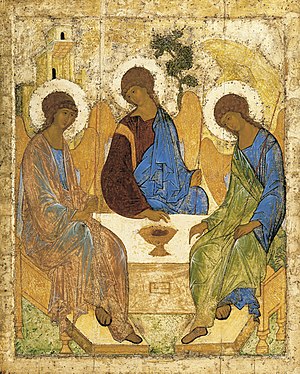| The Trinity | |
|---|---|
 | |
| Artist | Andrei Rublev |
| Year | 1411 or 1425–27 |
| Medium | Tempera |
| Dimensions | 142 cm × 114 cm (56 in × 45 in) |
| Location | Old Katholikon of the Trinity Lavra, Sergiyev Posad |
The Trinity (Russian: Троица, romanized: Troitsa, also called The Hospitality of Abraham) is an icon created by Russian painter Andrei Rublev in the early 15th century.[1] It is his most famous work[2] and the most famous of all Russian icons,[3] and it is regarded as one of the highest achievements of Russian art.[4][5] Scholars believe that it is one of only two works of art (the other being the Dormition Cathedral frescoes in Vladimir) that can be attributed to Rublev with any sort of certainty.[1]
The Trinity depicts the three angels who visited Abraham at the Oak of Mamre (Genesis 18:1–8), but the painting is full of symbolism and is interpreted as an icon of the Holy Trinity. At the time of Rublev, the Holy Trinity was the embodiment of spiritual unity, peace, harmony, mutual love and humility.[6]
The icon was commissioned to honour Saint Sergius of Radonezh of the Trinity Lavra of St. Sergius monastery, near Moscow, in the town of Sergiyev Posad. Little is known about The Trinity's history, and art historians make suggestions based on only the few known facts.[7] Even the authorship of Rublev has been questioned. Various authors suggest different dates, such as 1408–1425, 1422–1423 or 1420–1427. The official version states 1411 or 1425–27.
The icon was moved in 2022 under the direction of the Russian government back to the Trinity Lavra of St. Sergius, the spiritual centre of the Russian Orthodox Church. Curators have warned that moving The Trinity risks damaging it as it requires a precise temperature and humidity. Before this, the icon had been kept at the Tretyakov Gallery since 1929.[8] In 2023, the icon was, despite these objections, transferred to the custody of the Russian Orthodox Church and put on display at the Cathedral of Christ the Saviour in Moscow,[9] in 2024 the icon was transferred to Old Katholikon of the Trinity Lavra in Sergiyev Posad.[10]
- ^ a b Стенограмма расширенного реставрационного совещания в Государственной Третьяковской Галерее по вопросу "Троицы" Рублева 17 ноября 2008 года (in Russian). Retrieved 22 December 2008.
- ^ "The Trinity by Andrei Rublev" (in Russian). Tretyakov Gallery. Retrieved 22 December 2008.
- ^ Аверинцев, С. С. "Красота изначальная." Наше наследие 4 (1988): 25–26.
- ^ Дружкова, НАТАЛИЯ ИВАНОВНА. "современные визуально-коммуникационные средства в преподавании теории и истории изобразительного искусства [Электронный ресурс]." Педагогика искусства: электрон. науч. журн. Учреждения Рос. академии образования «Институт художественного образования 1 (2014).
- ^ "Explanation of Andrei Rublev's Icon". St John's Anglican Church. Archived from the original on 19 July 2008. Retrieved 22 December 2008.
- ^ Е.В.Гутов, ed. (27 April 2011). "1". Пасхальные чтения: Тезисы докладов студенческой научно-теоретической конференции (PDF) (in Russian). Нижневартовск: Издательство Нижневартовского государственного гуманитарного университета. pp. 4–5. ISBN 9785899888670.
- ^ "Holy Trinity of Andrei Rublev" (in Russian). AndreiRublev.ru. Retrieved 23 December 2008.
- ^ "The Kremlin drafts a much-loved icon for war propaganda". The Economist. ISSN 0013-0613. Retrieved 3 September 2022.
- ^ "In Photos: Renowned Orthodox Icon Displayed at Moscow Cathedral". The Moscow Times. 5 June 2023.
- ^ Икону "Троица" установили в Троицком соборе на ее историческом месте. РИА Новости, 23.06.2024.